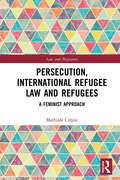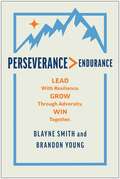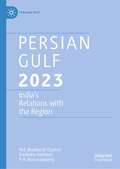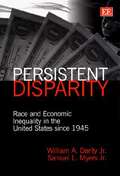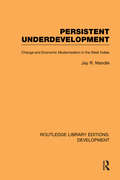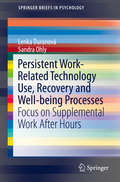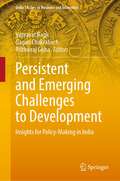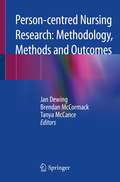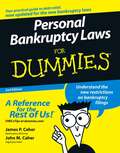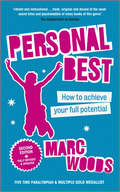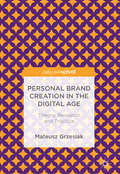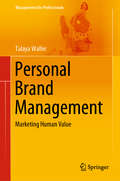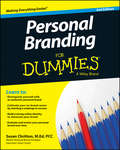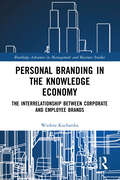- Table View
- List View
Persecution, International Refugee Law and Refugees: A Feminist Approach (Law and Migration)
by Mathilde CrépinThis book explores the ambit of the notion of persecution in international law and its relevance in the current geopolitical context, more specifically for refugee women. The work analyses different models for interpreting the notion of persecution in international refugee law through a comparative lens. In particular, a feminist approach to refugee law is adopted to determine to what extent the notion of persecution can apply to gender related forms of violence and what are the challenges in doing so. It proposes an interpretive model that would encourage decision makers to interpret the notion of persecution in a manner that is sufficiently protective and relevant to the profiles of refugees in the 21st century, most particularly to refugee women. The book will be of interest to academics and students in the field of public international law, international human rights law, international humanitarian law, immigration law, European law, and refugee law as well as those working in the areas of international relations.
Perseverance > Endurance: Lead with Resilience. Grow Through Adversity. Win Together.
by Blayne Smith Brandon YoungFrom the battlefields of Afghanistan and Iraq to the boardrooms of Nike, Walmart, and Microsoft, Blayne Smith and Brandon Young have consistently built tightly-knit, high-performing teams that persevere and win. Join the Army Rangers on the peaks of the Hindu Kush Mountains in Afghanistan and the Green Berets at Firebase Anaconda to gain key insights for leading teams through uncertainty and the understanding that perseverance is what&’s most required for today&’s complex world. Doubt crushes leaders daily—from GMs of Fortune 500 companies to small business owners across America, leaders nearly unanimously express doubt and fear in the face of adversity. This makes sense because adversity pushes us beyond our training and our comfort zones. We cannot simply put our heads down and endure. Instead, learn that adversity is an opportunity for transformation. When faced with circumstances beyond our capabilities, we must grow to meet those challenges by persevering and becoming the person the situation requires. Perseverance Over Endurance empowers leaders to gain clarity of their challenges, apply sound leadership principles, and lead their teams to victory by embracing the five factors of perseverance: Change: Factors outside of our control change fast and often. Uncertainty: We are confronted with situations beyond our training or capabilities, creating a sense of fear. Acceptance: Accept the consequences, embrace the reality of the situation, and surrender what we cannot control. Choice: Choose to become our creeds, values, and ethos and become the person your team and the situation call for. Growth: We will be changed on the other side, becoming better, wiser, and more confident leaders ready for the next big challenge. Discover a framework that has helped real organizations, including ThermoFisher Scientific, Siemens, GEICO, Ziggi's Coffee, SDA Colorado, Frontline Construction, Public Trust Advisors, and many more, learn to lead through adversity and win. From two US Army Special Operators turned business professionals who have built successful businesses and led teams to persevere and achieve no-fail missions in war, business, and life, this book will become a staple for leaders worldwide.
Perseverance Principles: How to Unlock Confidence, Consistency, and Wealth Under Pressure
by J. J. MazzoBuilt under pressure. Rooted in faith. Forged by fire. In Perseverance Principles, JJ Mazzo reveals a childhood marked by trauma, chaos, and instability… and the hard-won strategies that turned him into a disciplined, faith-driven leader. His gritty story is about a man who persevered to build confidence, consistency, and wealth when the odds were against him. This is an intensely personal and revealing game plan for self-leadership, teaching you how to overcome adversity to produce significant changes in your life. JJ shares difficult truths and the mindset, processes, and a personal code that helped him find peace and success. You'll discover how to: Build a foundation that doesn't crack under pressure Trade ego for execution and show up with real confidence Navigate adversity with clarity, consistency, and composure Stop chasing results and start producing them Apply discipline that outlasts your emotions Make peace with your past while building for the future Whether you're leading a company, a team, or just trying to lead yourself, Perseverance Principles gives you essential strategies to rise with strength, lead with integrity, and persevere when it matters most.
Pershing Square 2.0
by Robin Greenwood Samuel G. Hanson David BieryIn June 2015 William A. Ackman, the CEO and Founder of New York Hedge Fund Pershing Square Capital, reflects on the success of the fund he has spent over a decade building. Since its inception in 2004, Pershing Square's assets under management had grown from $500 million to well over $18 billion. Ackman is now considering a sizable new portfolio position and must decide how he should raise capital to undertake this new investment. This choice is affected by the recent launch of his new, $6 billion closed-end vehicle, Pershing Square Holdings, as well as the firm's lengthening investment horizon. Although always activist in nature, Ackman and his fund had in recent years become substantively involved in the management of portfolio companies, often working to drive shareholder value by improving operating performance.
Pershing Square's Pandemic Trade (A)
by Luis M. Viceira Emil Nuwan Siriwardane Dean Xu Lucas BakerThis case explores the decision that Bill Ackman, CEO and founder of the hedge fund Pershing Square Capital, was considering in late February 2020 about hedging the exposure of the fund's portfolio from the potential financial fallout ensuing from an extreme event like a global pandemic. Bill Ackman had become increasingly concerned about the hedge fund's exposure to a novel, highly infections, and lethal coronavirus that was spreading across the globe. Ackman and his team needed to decide whether this was a risk worth hedging, and if so, which hedging instruments would best balance risk mitigation, explicit costs (fees and premia), opportunity costs, and the long-run objectives of the fund. Ackman and his team considered fully liquidating their portfolio, as well as hedging it with futures, options, and credit default swaps. For each alternative, they also needed to determine the optimal size and maturity of the hedging position, after accounting for uncertainty over the trajectory of the virus. This case provides students with ample opportunities to analyze and understand tail risk and how to manage it in practice, including explicit calculations of position sizing, costs, risks, and benefits of hedging alternatives.
Pershing Square's Pandemic Trade (B)
by Luis M. Viceira Emil Nuwan Siriwardane Dean XuThis case explores the decision that Bill Ackman, CEO and founder of the hedge fund Pershing Square Capital, was considering in late February 2020 about hedging the exposure of the fund's portfolio from the potential financial fallout ensuing from an extreme event like a global pandemic. Bill Ackman had become increasingly concerned about the hedge fund's exposure to a novel, highly infections, and lethal coronavirus that was spreading across the globe. Ackman and his team needed to decide whether this was a risk worth hedging, and if so, which hedging instruments would best balance risk mitigation, explicit costs (fees and premia), opportunity costs, and the long-run objectives of the fund. Ackman and his team considered fully liquidating their portfolio, as well as hedging it with futures, options, and credit default swaps. For each alternative, they also needed to determine the optimal size and maturity of the hedging position, after accounting for uncertainty over the trajectory of the virus. This case provides students with ample opportunities to analyze and understand tail risk and how to manage it in practice, including explicit calculations of position sizing, costs, risks, and benefits of hedging alternatives.
Pershing Square's Pandemic Trade (C)
by Luis M. Viceira Emil Nuwan Siriwardane Dean XuThis case explores the decision that Bill Ackman, CEO and founder of the hedge fund Pershing Square Capital, was considering in late February 2020 about hedging the exposure of the fund's portfolio from the potential financial fallout ensuing from an extreme event like a global pandemic. Bill Ackman had become increasingly concerned about the hedge fund's exposure to a novel, highly infections, and lethal coronavirus that was spreading across the globe. Ackman and his team needed to decide whether this was a risk worth hedging, and if so, which hedging instruments would best balance risk mitigation, explicit costs (fees and premia), opportunity costs, and the long-run objectives of the fund. Ackman and his team considered fully liquidating their portfolio, as well as hedging it with futures, options, and credit default swaps. For each alternative, they also needed to determine the optimal size and maturity of the hedging position, after accounting for uncertainty over the trajectory of the virus. This case provides students with ample opportunities to analyze and understand tail risk and how to manage it in practice, including explicit calculations of position sizing, costs, risks, and benefits of hedging alternatives.
Pershing Square's Pandemic Trade (D)
by Luis M. Viceira Emil Nuwan Siriwardane Dean XuThis case explores the decision that Bill Ackman, CEO and founder of the hedge fund Pershing Square Capital, was considering in late February 2020 about hedging the exposure of the fund's portfolio from the potential financial fallout ensuing from an extreme event like a global pandemic. Bill Ackman had become increasingly concerned about the hedge fund's exposure to a novel, highly infections, and lethal coronavirus that was spreading across the globe. Ackman and his team needed to decide whether this was a risk worth hedging, and if so, which hedging instruments would best balance risk mitigation, explicit costs (fees and premia), opportunity costs, and the long-run objectives of the fund. Ackman and his team considered fully liquidating their portfolio, as well as hedging it with futures, options, and credit default swaps. For each alternative, they also needed to determine the optimal size and maturity of the hedging position, after accounting for uncertainty over the trajectory of the virus. This case provides students with ample opportunities to analyze and understand tail risk and how to manage it in practice, including explicit calculations of position sizing, costs, risks, and benefits of hedging alternatives.
Persian Gulf 2018: India's Relations with the Region (Persian Gulf)
by P. R. Kumaraswamy Md. Muddassir Quamar Manjari SinghThe Persian Gulf 2018 is sixth in the series published by MEI@ND and examines India’s bilateral relations with the countries along the Persian Gulf, namely, Bahrain, Iran, Iraq, Kuwait, Oman, Qatar, Saudi Arabia, UAE and Yemen. It focuses on developments during 2017 and offers a comprehensive account of the strategic, political, economic and cultural aspects of bilateral developments along with specific policy recommendations for India.The book also provides an in-depth analysis of internal dynamics of these countries.
Persian Gulf 2019: India’s Relations with the Region (Persian Gulf)
by Md. Muddassir Quamar P. R. KumaraswamyThe book is seventh in the annual Persian Gulf series published by MEI@ND. It is a comprehensive analysis of India’s bilateral relations with the nine countries in the Persian Gulf and the GCC and focusses on developments during 2018. It gives a comprehensive account of the strategic, political, economic and cultural aspects of bilateral developments and also provides in-depth analysis of internal dynamics of the Persian Gulf countries. The final chapter offers policy recommendations based on the current state of affairs.
Persian Gulf 2023: India’s Relations with the Region (Persian Gulf)
by Md. Muddassir Quamar P. R. Kumaraswamy Sameena HameedThe book is 10th in the Persian Gulf Series by Middle East Institute, New Delhi (MEI@ND) and 5th with Springer Nature. It focuses on regional developments in the Gulf and India’s relations with the region in the preceding years; hence, Persian Gulf 2023 focuses on events in 2022. The broad subject of the book is Indian foreign policy and international relations. The book is based on opensource data, statistics, and information including government and international organisations’ reports, reports published by important consultancy and research institutions focused on the Gulf region, news and media reports published in the Gulf region and India and should be of great interest to analysts, academics, journalists, students, and practitioners. Each chapter in the book has several tables and figures on economic indicators, bilateral trade, and energy-related developments. It is a reference work for anyone interested in the Gulf region and at the same time it offers valuable policy recommendations. Hence, it has both academic and policy relevance.
Persistent Disparity: Race And Economic Inequality In The U. S. Since 1945
by William A. Darity Samuel L. Myers. . . the authors raise serious questions that often are not dealt with much in the mainstream economics literature. . . . Persistent Disparity is an interesting book with a provocative thesis that challenges conventional thinking. . . John Lunn, Faith and Economics Darity and Myers provide a trenchant analysis of recent trends in US black-white income differences. The book provides useful counterweight to and pointed critique of a recent spate of economic articles arguing that income convergence is occurring and that remaining racial differences are due to differential skill attainment. J.P. Jacobsen, Choice Persistent Disparity provides a comprehensive examination of the magnitude and scope of racial economic disparity in the United States. The authors directly assess the extent of black economic progress in the US since World War II and address the controversy of whether the racial income gap is closing or widening as America approaches the 21st century. Darity and Myers explicitly make the connection between what the theory of racial inequality espouses and corresponding policy recommendations for remedying such disparity such as affirmative action and reparations. The authors challenge the cultural genetic explanation and advance a new theoretical explanation that incorporates a more expansive characterization of the nature and role of discrimination. They also conclude that conventional anti-discrimination efforts are unlikely to be sufficient to close the gap. This book will be essential reading for anyone interested in US social and economic history, political economy, African-American studies, and public policy.
Persistent Underdevelopment: Change and Economic Modernization in the West Indies (Routledge Library Editions: Development)
by Jay MandleFirst published in 1996, this insightful and informative text examines the post-emancipation and recent economic history of the Commonwealth Caribbean. Jay R. Mandle offers an explanation of the region’s continuing underdevelopment. Through the use of an analytical framework derived from the works of Marx and Kuznets, the book focuses attention on technological change as the driving force behind economic modernization. Persistent Underdevelopment begins by exploring how plantation agriculture had a limiting effect on industrial growth. Ultimately, plantation dominance receded; technological stagnation continued, however, and, under British colonial policy the Caribbean failed to modernise. The post-World War II era brought new efforts at modernisation through the economic policies of the left regimes of Manley, Burnham and Bishop. The concluding chapters point the way to policies that would enable the Caribbean to escape its current poverty and become an effective participant in world markets, finally achieving the goal of modern economic development.
Persistent Work-related Technology Use, Recovery and Well-being Processes
by Lenka Ďuranová Sandra OhlyTheaim of this work is to provide insight into the process of employee recoveryand well-being in regard to work-related ICT use during after-hours. Therefore,we discuss (1) theories that help us to understand the determinants andoutcomes of this behavior, (2) our core concepts recovery and well-being, and(3) previous empirical findings on ICT use after hours for work purposes. Onthe basis of literature review, we propose a new conceptual overall frameworkof ICT use after hours for work purposes with the focus on employee recoveryand well-being processes. Thereby, we posit ICT use after hours for workpurposes as potential stressor, resource, or demand (see action theory byHacker, 1998, 2003; Frese and Zapf 1994), depending on many personal and environmentalfactors, but primarily on cognitive appraisals (see transactional model ofstress by Lazarus and Folkman 1984). This three-way division enables us topropose various linear and non-linear associations to focused outcomes. Weconclude with an overall discussion on further research concerning theidentified research gaps.
Persistent and Emerging Challenges to Development: Insights for Policy-Making in India (India Studies in Business and Economics)
by Gagari Chakrabarti Supravat Bagli Prithviraj GuhaThis book covers a wide range of the issues in development studies. Recognizing the existence of manifold challenges in achieving and sustaining economic development, it is divided into four sections—(i) The Macroeconomy: Foreign Trade, Structural Transition and the Environment, (ii) Health and Standard of Living, (iii) Education, Human Capital and Evolution of the Employment Quality in India, and (iv) Banking and Credit: Access, Efficiency and Stability. The book brings together a right mix of senior and young economists who use cutting edge econometric techniques and/ or revisit a perennial question with much sharper focus and tools to unravel insights that are important and will inform tomorrow’s theorisation and policy making. The volume looks at important questions like spatial concentration of low infant and child health outcomes, trade liberalisation and export quality, intergenerational occupational mobility, multidimensional poverty incidence in rural India, robustness of the banking sector, to name a few. To do so, the contributions use novel and esoteric methods like machine learning, spatial econometrics, system GMM, quintile regression and counterfactual decomposition (QRCD), and so on. The rich collection holds importance for researchers and policy makers alike, and also for practitioners working in different developmental sectors..
Person-centred Nursing Research: Methodology, Methods and Outcomes
by Jan Dewing Brendan McCormack Tanya McCanceThis book is the first ever to offer a contemporary collection of different perspectives on person-centredness in international doctoral nursing research. The research in the book is based on the ideas and values of personhood and person-centeredness, which have been used and can be seen to guide research approaches, inform research designs and theorize research findings. Further, a specific framework for person-centred nursing is embedded throughout the research studies presented in the text. The Person-centred Nursing Framework (PCNF) developed by Brendan McCormack and Tanya McCance in 2010, is recognized as a nursing theory and this book further develops it as a basis for research and for advancing person-centredness in nursing. The framework informs all stages of the research process, from design through to dissemination.The book is structured into a number of highly engaging chapters written by doctoral candidates, and recently graduated candidates. The opening and closing chapters, written by the editors, place the subsequent chapters in a global context of person-centredness and nursing. The potential for person-centred nursing research to be a global movement is recognized and debated. The subsequent chapters lead readers through philosophical ideas, methodologies and methods whilst also offering reflective and honest insights into learning how to become a person-centred researcher. This field is growing and developing but yet there is no specific book available. As a result, researchers spend considerable time and effort translating existing research methodologies into person-centred perspectives. This book fills this gap and acts as a key resource for future nurse researchers. The text is intended for, and benefits nursing doctoral candidates, masters candidates and academic staff who teach and supervise research candidates; it may also appeal to other graduate learners. The book has international contributions which makes it appealing internationally.
Personal Bankruptcy (2nd edition)
by Stephen R. EliasThis convenient personal bankruptcy kit provides step-by-step instructions and all the forms necessary to file for Chapter 7 bankruptcy. It explains how to: * assess the short and long-term effects of bankruptcy * obtain an "automatic stay" to keep creditors at bay * cancel or reschedule debts * appear in bankruptcy court * decide whether to see a lawyer and more. This second edition has been completely revised and updated. Good in all 50 states.
Personal Bankruptcy Laws For Dummies
by James P. Caher John M. CaherWith tips on understanding -- and surviving -- the new bankruptcy laws If you're considering bankruptcy, you need straightforward answers and reliable advice. This handy guide covers it all -- so you can get your finances in line and your life back on track. This updated new edition covers everything you need to know about the new bankruptcy law and includes even better resources. Don't get desperate -- get out of debt instead! Discover how to * Weigh the consequences of bankruptcy * Manage your spending * Find professional help you can trust * Decide on the right type of bankruptcy * Pass the means test * Keep more of your stuff
Personal Benchmark: Integrating Behavioral Finance and Investment Management
by Charles Widger Daniel CrosbyIn Personal Benchmark: Integrating Behavioral Finance and Investment Management, Chuck Widger and Dr. Daniel Crosby outline the ways in which a program of embedded behavioral finance, fueled by what matters most to you, can be your protection against irrational financial behavior. <P><P>Along the way, you'll learn how to improve your investment experience, increase returns formerly sacrificed to misbehavior, and worry less about "The Economy" as you become increasingly focused on "My Economy." Welcome to a new way of investing, a new paradigm for conceptualizing wealth, and a system of turning emotion from your portfolio's worst enemy into its best friend! In this new model, risk is simply the likelihood that we will underperform our dreams. Irrationality is acting in ways that thwart our ability to reach those dreams. And the optimal portfolio is not the one that generates the highest return in abstraction, it is the one that helps us meet our goals without killing our nerves before we get there. This book gives advisors the tools needed to effectively communicate the design and execution of the Personal Benchmark solution.
Personal Best
by Marc WoodsFROM MARC WOODS "I love to read and listen to inspirational stories, but sometimes it is difficult to apply any of their content to your own life. In writing Personal Best I wanted to share my life experiences, to relate how I dealt with, and overcame, the different challenges that I faced and then went on to achieve success. But, more importantly, I wanted to do it in a way that might be useful to others. In beating cancer as a teenager, I may have lost a leg, but I gained a new respect for life and a second chance. My experience taught me to approach life in a different way. It taught me to measure myself against my potential and not against others. It taught me about personal responsibility. It taught me that life is about being the best person you can be. If you are lucky, life teaches you what you don't learn at school. I've been very lucky. I've learnt some tough, but invaluable lessons about life on my journey. I'd like to share those lessons with you. " "Personal Best is a truly inspirational book, written with great honesty, compassion and humility. Marc's ability to overcome adversity and triumph in so many diverse areas is an example to us all. His immense sporting achievements and his work on behalf of the Teenage Cancer Trust is unequalled and his indomitable spirit shines through. " -Sarah, the Duchess of York "Marc has a remarkable story and is an absolute inspiration. " -Roger Daltrey
Personal Brand Creation in the Digital Age: Theory, Research And Practice
by Mateusz GrzesiakPresenting a scientific exploration of personal branding and digital communication, this ground-breaking book aims to fill a gap between theory and practice. Describing how social media can increase brand profiles online, it explains basic terms before investigating the cultural context for online personal branding. With a special focus on YouTube, the author provides a comparative analysis of two countries (USA and Poland) to open further avenues for research into this growing area. An essential read for management and marketing scholars, this study outlines and explores the evolution of media in the digital age from a business perspective, and offers a thought-provoking analysis for those interested in social media.
Personal Brand Management: Marketing Human Value (Management for Professionals)
by Talaya WallerThis book is the definitive resource for understanding the phenomena and process of personal brand management as it becomes increasingly valued in a global economy. By providing a research-based, theoretical framework, the author distills the concept of personal branding as it is applicable to individuals throughout all stages of career development as well as across industries and disciplines.Extensively researched with numerous case studies, this book clearly outlines the strategic process of evaluating the economic value of a personal brand to manage and scale it accordingly. The author, an expert in the field of personal brand strategy and management, argues that a business is what a person or organization does, but the brand is what people expect from that person or organization. The two must align, and the book’s conceptual framework explains the theory and practice behind personal branding to accomplish this synergism.The consequence of the digital age is unprecedented visibility for individuals and businesses. As they engage with one another in more and more virtual spaces, the need for understanding and managing the evolving complexity of this ‘personal’ engagement is an economic reality. For this reason, the framework in this title provides insight and perspective on all phases of a brand in its recursive life cycle both on and offline. By providing clarity and structure to the topic as well as practical theory for its application, this title is the ultimate primer on personal branding in theory and practice.
Personal Branding For Dummies
by Susan ChrittonThe fun way to create and maintain personal brandingDistinguishing yourself from the competition is important in any facet of business. Creating a clear and concise image, reputation, and status in the professional world provides an edge, whether searching for a first job, exploring a change in career, or looking to be more viable and successful in your current career. Personal Branding For Dummies is a guide through the steps of creating and maintaining a personal trademark by equating self-impression with other people's perception.Personal Branding For Dummies covers everything you need to create your personal branding, including: using different organizations and associations to increase visibility and exposure to both clients and competitors; making the most of networking; tapping into Social Media outlets like Facebook, Twitter, and LinkedIn to showcase a personal brand; building a persona through websites and blogging; evaluating personal style and appearance; using conversation, negotiation, and sales techniques best suited to a personal brand; monitoring your brand reputation and successfully implementing feedback as it grows and develops, and more.Tips on utilizing Social Media to showcase your personal brandHow personal branding can help advance your careerGuidance on creating a clear and concise imageWith the hands-on, friendly help of Personal Branding For Dummies, you'll establish a professional presence and personal "brand" identity to keep yourself distinguished in the business world.>
Personal Branding for Entrepreneurial Journalists and Creative Professionals
by Sara KellyPersonal Branding for Entrepreneurial Journalists and Creative Professionals outlines and describes the complete process of building and growing a successful personal brand. Focused on the independent journalist or creative professional in the new digital marketplace, Sara Kelly gives readers the ability to create the sort of personal brand that not only stands out, but remains relevant for years to come. Features such as exercises and worksheets will guide readers in creating the various components of their personal brand, and case studies of real-world branding scenarios will allow readers to analyze the practical aspects of implementing a personal brand. Covering theory and practice, this text is a powerful resource for modern journalists, multimedia storytellers, and content creators hoping to ply their talents online and beyond.
Personal Branding in the Knowledge Economy: The Inter-relationship between Corporate and Employee Brands (Routledge Advances in Management and Business Studies)
by Wioleta KucharskaPersonal Branding in the Knowledge Economy: The Interrelationship between Corporate and Employee Brands aims to contribute to the academic debate about the marketization of individuals’ knowledge, creativity, and personal images, alongside a growing interest in the whole area of branding in the networked economy based on knowledge. Personal branding and personal knowledge are critical assets of knowledge workers and key drivers of their development and innovative performance. Both strongly influence the individual success of knowledge workers in the networked and knowledge-driven economy. Personal brands are dynamically shifting from the side-lines to the center of the modern economy and the authenticity of the brands of personal ingredients for their ability to create value. They are one of the three key pillars of value creation in the social media environment, therefore significantly contribute to digital business models. The book will be of interest to researchers, academics, professionals, and students in the fields of organizational branding, marketing, management, and communications.
